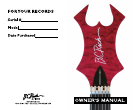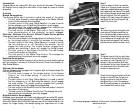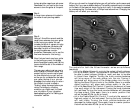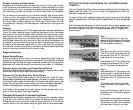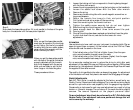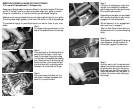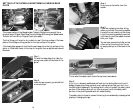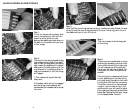
When you do need to change batteries you will get better performance and
battery life if you use an alkaline battery. The battery compartment is located
on the back of the bass just above the control cavity. It can easily be opened
by unscrewing the 2 screws with a Phillips head screwdriver. Changing the
battery will not affect your warranty.
The controls for both the NJ and Innovator series are as follows:
(see photo)
• #1 is the Master Volume. It controls the output of both pickups.
• #2 is the Blend Control. The purpose of the Blend Control is to
be able to select pickups (bridge or neck) and also to be able
to blend them together. Turning the knob counterclockwise
will bring more of the neck pickup into the mix. Turning it
clockwise will bring more of the bridge pickup into the mix.
Setting the Blend Control knob in the middle (there is a middle
detent position) will place each pickup evenly in the mix.
• #3 is the Bass Boost/Cut Control. It controls the amount of bass
(low end) output of the instrument. Turning the knob clockwise
will add bass. Turning the knob counterclockwise will decrease
the bass output. Once again, there is a center position that
will set the bass EQ flat (no cut or boost).
• #4 is the Treble Boost/Cut Control. It controls the amount of
high-end output of the instrument. Turning the knob clockwise
will add treble. Turning the knob counterclockwise will
decrease the treble output. Once again, there is a center position
that will set the treble EQ flat (no cut or boost).
tuning using the range tuner set screw.
Remember: do not use the fine tuner
screws to tune the guitar at this point.
Step 4:
A range tuner setscrew is located in
the nose of each pivoting saddle.
Step 5:
Using a 1.5mm Allen wrench and the
range tuner setscrew, tune your guitar
to any tuning you desire. You can
increase the pitch of a given string by
turning the setscrew clockwise, and
decrease the pitch of the string by
turning the setscrew counter-
clockwise. (Remember not to use the
fine tuner screws for this tuning.)
Now that you have tuned your guitar
to the tuning you want, the bridge
should be properly setup, and the fine
tuners should be set to the middle of
their range.
The way your guitar is set up now is
what is called a "blocked" setup. This
means that the tremolo can be used
for dive effects but you can't pull up
on the arm for up bends. You can leave
your guitar the way it is, or you can
disengage the tremolo stop to return
the tremolo to what is called a
"floating" setup. However, before you
return the bridge to a floating
condition, you might want to check
your intonation. If your intonation
needs adjusting, go to the "Setting your
intonation" section.
14 3



